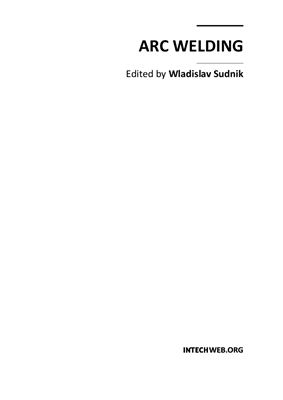InTech. 2011. 330 p.
Ever since the invention of arc technology in 1870s and its early use for welding lead during the manufacture of lead-acid batteries, advances in arc welding throughout the twentieth and twenty-first centuries have seen this form of processing applied to a range of industries and progress to become one of the most effective techniques in metals and alloys joining. The objective of this book is to introduce relatively established methodologies and techniques which have been studied, developed and applied in industries or researches. State-of-the-art development aimed at improving technologies will be presented covering topics such as weldability, technology, automation, modelling, and measurement. This book also seeks to provide effective solutions to various applications for engineers and researchers who are interested in arc material processing. This book is divided into 4 independent sections corresponding to recent advances in this field.
Contents
Preface
Part 1 Arc Welding Technology
Hardfacing by Plasma Transferred Arc Process
Fusion Welding with Indirect Electric Arc
Part 2 Arc Welding Automation
Arc Welding Automation
WHI Formula as a New Criterion in Automatic Pipeline GMAW Process
Sensors for Quality Control in Welding
Part 3 Weldability of Metals and Alloys
Weldability of Iron Based Powder Metal Alloys Using Pulsed GTAW Process
Assessment of Stress Corrosion
Cracking on Pipeline Steels Weldments Used in the Petroleum Industry by Slow Strain Rate Tests
Evaluation of the Shielding Gas Influence on the Weldability of Ferritic Stainless Steel
Corrosion Fatigue Behaviour of Aluminium 5083-H111 Welded Using Gas Metal Arc Welding Method
Part 4 Mechanisms, Models, and Measurements of Arc Welding
The Mechanism of Undercut Formation and High Speed Welding Technology
Physical Mechanisms and Mathematical Models of Bead Defects Formation During Arc Welding
Using Solid State Calorimetry for Measuring Gas Metal Arc Welding Efficiency
Chemical and Physical Properties of Fluxes for SAW of Low-Carbon Steels
Arc Welding Health Effects, Fume Formation Mechanisms, and Characterization Methods
Ever since the invention of arc technology in 1870s and its early use for welding lead during the manufacture of lead-acid batteries, advances in arc welding throughout the twentieth and twenty-first centuries have seen this form of processing applied to a range of industries and progress to become one of the most effective techniques in metals and alloys joining. The objective of this book is to introduce relatively established methodologies and techniques which have been studied, developed and applied in industries or researches. State-of-the-art development aimed at improving technologies will be presented covering topics such as weldability, technology, automation, modelling, and measurement. This book also seeks to provide effective solutions to various applications for engineers and researchers who are interested in arc material processing. This book is divided into 4 independent sections corresponding to recent advances in this field.
Contents
Preface
Part 1 Arc Welding Technology
Hardfacing by Plasma Transferred Arc Process
Fusion Welding with Indirect Electric Arc
Part 2 Arc Welding Automation
Arc Welding Automation
WHI Formula as a New Criterion in Automatic Pipeline GMAW Process
Sensors for Quality Control in Welding
Part 3 Weldability of Metals and Alloys
Weldability of Iron Based Powder Metal Alloys Using Pulsed GTAW Process
Assessment of Stress Corrosion
Cracking on Pipeline Steels Weldments Used in the Petroleum Industry by Slow Strain Rate Tests
Evaluation of the Shielding Gas Influence on the Weldability of Ferritic Stainless Steel
Corrosion Fatigue Behaviour of Aluminium 5083-H111 Welded Using Gas Metal Arc Welding Method
Part 4 Mechanisms, Models, and Measurements of Arc Welding
The Mechanism of Undercut Formation and High Speed Welding Technology
Physical Mechanisms and Mathematical Models of Bead Defects Formation During Arc Welding
Using Solid State Calorimetry for Measuring Gas Metal Arc Welding Efficiency
Chemical and Physical Properties of Fluxes for SAW of Low-Carbon Steels
Arc Welding Health Effects, Fume Formation Mechanisms, and Characterization Methods

